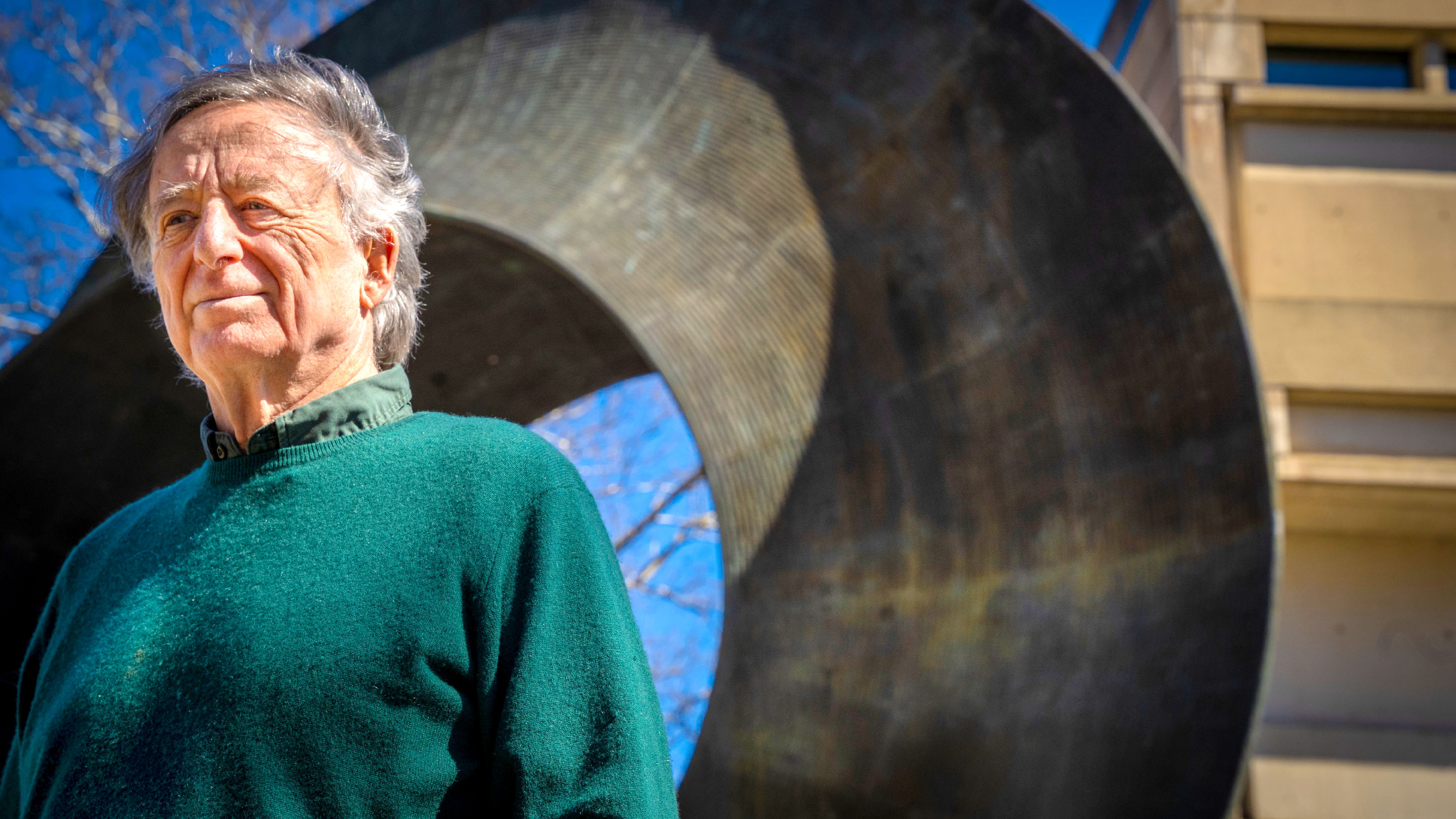Dennis Sullivan, Uniter of Topology and Chaos, Wins the Abel Prize

Dennis Sullivan at Stony Brook University.
John Griffin/Stony Brook University
Introduction
Dennis Sullivan has always been driven by mathematical insights that are general and beautiful and have the power to amaze — “something that grabs you, like a piece of music,” he said. An encounter with one such theorem during his second year of college spurred him to switch his major from chemical engineering to mathematics; other encounters like it would later inspire him to spend years or even decades on a particular problem.
Now Sullivan, a mathematician at Stony Brook University and the City University of New York whose work in topology and dynamical systems has led to powerful new insights of his own, has been awarded the Abel Prize, one of the highest honors in mathematics. The prize committee recognized Sullivan “for his groundbreaking contribution to topology” — the study and classification of shapes — as well as his ability to decipher a wide range of mathematical problems by viewing them through a geometric lens.
“He has really been one of the most influential characters in modern topology … since the 1960s,” said Hans Munthe-Kaas, a mathematician at the University of Bergen and the chair of the Abel Prize committee.
Sullivan has dedicated much of his career to understanding topological spaces called manifolds — spaces that look flat (or like an ordinary coordinate space) when viewed from any point on their surface, but that have a more complicated global structure. The surface of a sphere and the surface of a torus, for instance, are both two-dimensional manifolds.
Sullivan set his sights on such shapes in higher dimensions. He provided a complete classification of manifolds of a particular type in five or more dimensions, and made significant progress on a problem related to different ways of dividing manifolds into smaller triangular pieces. In pursuit of both those goals, he helped to further develop an area called surgery theory, which involves changing one manifold into another by cutting and regluing pieces of it.
Some of his most groundbreaking work, delineated in a set of notes circulated informally in 1970, involved cutting to the core of “what it really means to have a space which has the topology of a manifold” by looking at it from other perspectives, Sullivan said.
Often, mathematicians study a topological shape by associating it with algebraic objects called homotopy groups that capture important properties of the shape. These groups might describe, for instance, how loops can intersect and be arranged in the space. But because the groups can be very difficult to compute, Sullivan helped develop a technique whereby the information “could be broken into boxes,” he said, and “each one could be treated separately.” Having made those simpler calculations, “you could get back the full story” and better understand the manifold of interest.
To do this, Sullivan essentially invented a notion of division, where loops on the original manifold were divided into two or three or more. Even though doing this meant replacing the manifold with a much more complicated-looking object, it allowed him to deal with homotopy groups that involved fractions rather than integers. And the introduction of fractions into the algebra “makes life much simpler when you’re counting things,” he said, and could be used to prove certain properties.
“It just enables a different kind of discourse,” said Shmuel Weinberger, a mathematician at the University of Chicago. He compared Sullivan’s innovations to chemical or genetic analysis in that they “let you break things up into fundamental pieces that look extremely different from the original object.”
The technique itself wasn’t the part that stood out for Sullivan. “It was like an exercise to me,” he said. To him, what mattered more was that it allowed him to show that symmetry and other properties existed in this divided or “local” sense, which turned out to be crucial for proving certain statements that would have otherwise eluded him (including a notable result related to the homotopy groups of spheres). He ultimately used this way of studying manifolds to prove several important results in topology.
“He was like a fresh wind from the outside” in terms of both his ideas and his personality, said Nils Baas, a mathematician at the Norwegian University of Science and Technology, reflecting on when he first met Sullivan more than 50 years ago. “His contributions are so many and profound, this prize is well deserved.”
Sullivan’s efforts to capture the very essence of a space didn’t stop there. In the late 1970s, in parallel with the mathematician Daniel Quillen, he founded what’s called rational homotopy theory: a way to ignore certain information about the topology of a manifold so that the remaining information can be packaged in an easier, more tractable way.
The work was once again motivated by the fact that homotopy groups can often be nearly impossible to compute. “Spaces are really hard to understand. In some sense, we don’t even understand what spheres are from this purely [algebraic] point of view,” said Ulrike Tillmann, a mathematician at the University of Oxford and a member of this year’s Abel Prize committee. Rational homotopy theory is geared toward simplifying that algebraic translation to something “much more tangible,” she said, so that mathematicians can still say something about the spaces they’re interested in and what those spaces are equivalent to.
In this streamlined context, Quillen and Sullivan used different algebraic models to understand their manifolds. Sullivan’s approach was notable because it relied on tools from calculus to capture information about different spaces. “He was much more concrete in his attack,” said Munthe-Kaas. “It allowed people to really compute with these structures.”
His invention of rational homotopy theory is “a wonderful piece of art,” said Étienne Ghys of the École Normale Supérieure in Lyon, France. “It’s just a great moment in the history of mathematics.” It provided the opportunity to study spaces in ways that had seemed completely inaccessible before.
Yet Sullivan described it once again as “an exercise.” What excited him, he said, was that it became the key to answering other questions he’d been wondering about, including one that resulted in what he called “the theorem of my life” — even though people hardly paid attention to it, focusing more on the development of rational homotopy theory and the doors it would open. “There’s no justice, in some sense,” he quipped.
Heading into the 1980s, Sullivan’s work was almost entirely focused on manifolds from what he called an “outside,” more global perspective — one in which, by definition, “the manifold doesn’t really have any local personality,” he said. “It doesn’t have a texture to its skin. It has no beauty marks. Every place looks like every other place … like a puddle of milk.”
He wanted to find that local personality. And so he switched gears and turned his attention to dynamical systems, the study of motion within or through a space. “A dynamical system has different textures in different parts of the manifold,” he said. “Dynamics was really a new world.”
At that time, there was renewed interested in studying the complicated dynamics that could arise from the iteration of even simple functions. Consider a function like f(z) = z2 + 1, and plug in a complex number (a number that has a real and an imaginary part). Then take the answer, plug it back into the function, and repeat. The result is a sequence of points that form elaborate fractal paths through the complex plane. Sullivan proved a 60-year-old conjecture about how points (and their surrounding domains) in these kinds of systems eventually return to their starting place, rather than wandering around forever.
To demonstrate this and other results (including one related to the mathematics underlying a universal property of certain chaotic systems), he forged connections between two seemingly unrelated fields: the study of dynamical systems generated from iterating functions, and the study of certain groups of symmetries that act on a particular kind of geometric space. The so-called Sullivan’s dictionary “built bridges … and changed both subjects,” said Weinberger.
In the early 2000s, Sullivan returned to the outside view of topology that characterized the early years of his career. Alongside Moira Chas, a mathematician at Stony Brook (and his wife), he developed a new way to classify manifolds by studying loops and paths on their surfaces.
Now he’s begun to combine his interests in topology and dynamical systems even more seamlessly. He is investigating fluid flows and the equations that describe them from a topological perspective.
“I’m not sure he sees the boundaries between different areas of mathematics the same as other people see it,” said Munthe-Kaas.
Update: On March 25 this article was updated to include Sullivan’s affiliation with the City University of New York.



